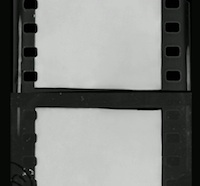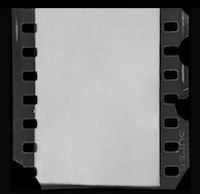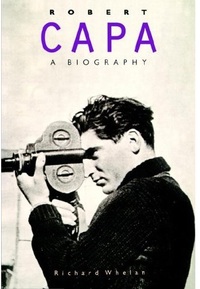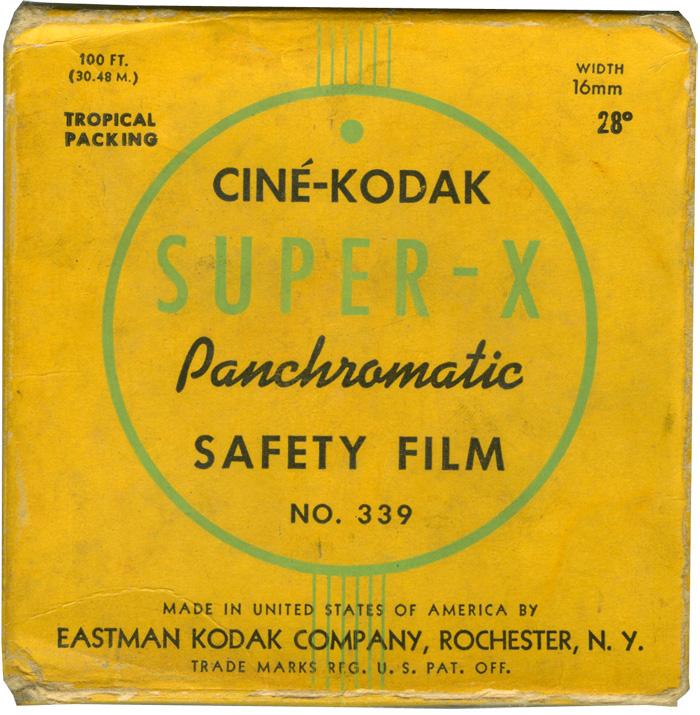
Seconding That Emulsion
As Ross Baughman argued in his Guest Post here, and as I began to elaborate in my own extension of Baughman’s inquiry, the story that former LIFE picture editor John Morris has told for 70 years about the ruining of Robert Capa’s D-Day negatives by an overzealous teenage darkroom assistant who mistakenly closed the doors of a heated, unventilated film-drying cabinet begins to fall apart as soon as one examines the remaining physical evidence and pays attention to the physics and chemistry involved.
It mortifies me to admit that I accepted this fable uncritically for almost half a century. In my defense, I’ve never worked as a photographer, though I have some darkroom experience and some understanding of cameras and films. So it astonishes me that no one with expertise in photography has challenged this myth until now. Consider my posting of Baughman’s essay, and these comments of mine, as penance.
Just the Facts, Ma’am
Since the surviving exposures were made while Capa was still aboard the landing craft that brought him to the battlefield, then while he made his way to shore, and then from the shore looking seaward, I would tend to assume that they came at the beginning of a roll, though Capa indicates that the last of them came at the end of a roll. One way or another, they would have hung at either the top or the bottom of the cabinet when put there to dry after development.

* “Behind the Photo: Robert Capa’s D-Day” (2014), screenshot
Viewing the samples of the purportedly heat-damaged films that appear in the short video “Behind the Photo: Robert Capa’s D-Day,” the first time I’ve had the opportunity to see them, I can’t help but notice that there’s emulsion distributed evenly in the rectangles where the exposed image would normally appear — apparently undamaged emulsion, albeit uniformly overexposed, with no trace of any image anywhere. At the same time, there’s no emulsion between those rectangles, and no emulsion between the borders of the image areas and the outer edges of the film strip with the socket holes.
Emulsion simply doesn’t melt and run that selectively on hanging strips of film. If it actually melted, it would appear thinner in some areas, thicker in others, and, like warm Jell-O, would ooze indiscriminately right over the previously cleared gaps between exposures and the areas at the edges of the film strips. Some fragments of dissolved imagery, even if grossly distorted, would appear therein. As Baughman points out, this looks not like heat-damaged emulsion but like film subjected to severe overexposure while in the camera, due to some faulty setting or jamming of the shutter and/or shutter release.
So, contrary to Morris’s narrative, these “damaged” frames actually show us samples of film that has received proper development, fixing, and drying. They also appear to have suffered drastic in-camera overexposure. If they typify the three rolls that held Capa’s estimated 106 exposures from Omaha Beach, then all but the “Magnificent Eleven” frames arrived at LIFE‘s London offices irreversibly overexposed (by Capa himself) in their pupal or latent-image stage.
The fact that Capa returned to Normandy from England early the next day with the same two Contax II cameras, continuing to use them daily for the next month as he followed the Allies through France, indicates that camera malfunction or equipment failure played no part in the overexposure of his Omaha Beach negatives. This was a case of operator error, plain and simple.
I’ll Stop the World and Melt with You
 “The Story Behind Robert Capa’s Pictures of D-Day,” the brief 2013 retelling of Morris’s version by Cynthia Young, Curator of the Capa Archives at the International Center of Photography in New York, seems intended in large part to explain away those contrary facts and deflect attention from the actual evidence. The 15-year-old darkroom assistant, Dennis Banks, Young writes, “had put the 35mm negatives in the drying cabinet with the heat on high and closed the door. With no air circulating, the film emulsion had melted.” She continues,
“The Story Behind Robert Capa’s Pictures of D-Day,” the brief 2013 retelling of Morris’s version by Cynthia Young, Curator of the Capa Archives at the International Center of Photography in New York, seems intended in large part to explain away those contrary facts and deflect attention from the actual evidence. The 15-year-old darkroom assistant, Dennis Banks, Young writes, “had put the 35mm negatives in the drying cabinet with the heat on high and closed the door. With no air circulating, the film emulsion had melted.” She continues,
Although ten of the 35mm negatives were usable, the emulsion on them had melted just enough so that it slid a bit over the surface of the film. Consequently, sprocket holes — which would normally punctuate the unexposed margin of the film — cut into the lower portion of the images themselves. Ironically, the blurring of the surviving images may actually have strengthened their dramatic impact, for it imbues them with an almost tangible sense of urgency and explosive reverberation.

* “Behind the Photo: Robert Capa’s D-Day” (2014), screenshot
But roll film gets hung to dry lengthwise — that is, with one end of the roll suspended from the top of the drying cabinet and the other end hanging weighted at the bottom. Young asks us us to believe that, in this situation, melting emulsion slid not directly downward, as gravity would have it, or even diagonally down, but horizontally — neatly and exactly the same fraction of an inch sideways in every existing frame. Either Young does not understand basic physics and the mechanics of the 35mm camera and film or she takes her readers for fools.
As Ross Baughman points out, the sprocket holes’ overlapping of the frames resulted not from Young’s fanciful post-development lateral “emulsion slide” but from Capa’s misloading of that 35mm film canister into his Contax — or, if indeed bulk-loaded, some minor misalignment of the unexposed film within the Contax cassette. (In an email to me, Baughman wrote, “I find it very odd that even the ruined pictures show the kind of edge notches that instruct the darkroom which pictures to print. I wonder why these disastrous exposures were even marked that way, but one possibility is that there is some faint shadow detail preserved on the negatives that we can’t see on a video of an old proof sheet, already less able to show everything we might detect from hand inspection.”
Moreover, if Young’s proposed minimal shift of the emulsion happened on this one section of one roll while leaving the negative image largely intact, how does she explain the complete disappearance of the negative images on the remaining frames of that roll (as seen in the samples) and, presumably, on the other two discarded rolls?

Richard Whelan, “Robert Capa: A Biography” (1994), cover.
If the emulsion didn’t slide in the fashion Young imagines, then that movement didn’t “ironically” enhance these images by blurring them and thus “imbu[ing] them with an almost tangible sense of urgency and explosive reverberation.” Pretty to think so, as Hemingway (no slouch at irony) would say.
Tellingly, Young plagiarized that last sentence from page 214 of Richard Whelan’s 1994 book Robert Capa: A Biography. Copy-pasting it in immediately after the sentence about “emulsion slide” without crediting its source deliberately implies a connection between the two. This apparently led “investigative journalist” Marie Brenner to conflate them without fact-checking in her hagiographic June 2014 paean for Vanity Fair: “The blurring from the drying cabinet had imbued the images with seismic drama.”

Cynthia Young, “The Story Behind Robert Capa’s Pictures of D-Day,” June 6, 2013, screenshot from ICP website 2014-06-12 at 11.38.23 AM.
Young and Brenner need to take deep breaths, learn a little about photography, and keep Occam’s razor in mind. The blurring happened during exposure, not after development.

Ciné-Kodak Super-X film package
Compare the 50 ASA speed rating of Capa’s Ciné-Kodak Super-X to the 400 ASA rating of Kodak Tri-X (not introduced by Kodak until 1954) or Kodak’s more recent 400 ASA T-Max and we need no arcane explanation for the blurriness of Capa’s 11 exposures — made by a frightened man while standing in a rocking boat, wading through the surf toward the shore, or crouching wet and shivering on a chilly beach under bombardment at dawn on an overcast day. Even Kodak’s current T-Max 100, billed as “The world’s finest-grained 100-speed black-and-white film,” is twice as fast as Super-X.
(There’s other nonsense in Young’s story. For example, she asserts that Capa “remained photographing on the beach for about an hour and a half that morning until his film was used up.” You can take this to the bank: Robert Capa didn’t go to Omaha Beach on D-Day with a mere four rolls of 36-exposure Super-X film. Capa stayed on Omaha Beach for only 30 minutes at most because he got scared and ran away. He had plenty of film left. According to his memoir, he reloaded both his Contax II 35mm cameras as soon as he got onto the evacuation boat.)
D-Day S’mores, Anyone?
The trouble with stories like this one of the magic melting emulsion is that they take on a life of their own.
 For example, you’d think that a site intended mainly as an information source for photographers, such as The Imaging Resource, would bring some photographic savvy and common sense to bear on such a legend. Instead, they go off the deep end with an elaboration of the received version of the emulsion tale: “[A]n excited darkroom assistant, while drying the negatives had used on too much heat causing the film emulsion to melt before his eyes, running down the hanging strips before he could do anything,” Steve Meltzer wrote in a 68th anniversary story on June 6, 2012. I’m surprised he didn’t have LIFE’s darkroom crew making D-Day S’mores with the stuff.
For example, you’d think that a site intended mainly as an information source for photographers, such as The Imaging Resource, would bring some photographic savvy and common sense to bear on such a legend. Instead, they go off the deep end with an elaboration of the received version of the emulsion tale: “[A]n excited darkroom assistant, while drying the negatives had used on too much heat causing the film emulsion to melt before his eyes, running down the hanging strips before he could do anything,” Steve Meltzer wrote in a 68th anniversary story on June 6, 2012. I’m surprised he didn’t have LIFE’s darkroom crew making D-Day S’mores with the stuff.
To counterbalance this mindless, uninformed, misleading blather, some facts:
- Film emulsion doesn’t melt at room temperature. It doesn’t melt at body temperature, even in your pocket when you’re running a fever. It doesn’t melt in a backpack or a metal camera on a hot summer day. From what I can find online, “Gelatin withstands dry heat at 100°C [212°F] for several weeks.” A typical professional-quality stainless-steel drying cabinet with a 40-roll capacity offers a heat thermostat adjustable to 165°F.
- By the early 1940s, Kodak and other manufacturers had long since incorporated hardeners into their emulsions, specifically for the purpose of inhibiting or preventing the swelling and/or melting of those emulsions before and after exposure and development. See this patent from 1936, and this patent from 1941. Hardeners also strengthen the adhesion of the emulsion to its backing. (See Kodak Publication J-1: Processing Chemicals & Formulas for Black-and-White Photography for details.)
The photographer and technical maven Ctein, who directed my attention to these patents, wrote,
“Quickly skimming them, I observed that Kodak referred to hardened emulsions standing up to temperatures of 50 Celsius or more. That is, over 120°F. I once built a small test chamber to achieve those kind of temperatures (to find out how heat-sensitive film really was — the answer is, ‘Not very much at all’). As you discovered, it takes a considerable amount of heat input. And those were chambers without any air circulation, which would be clearly contraindicated for any sort of a drying cabinet.”
Another highly reputed technical expert I consulted, a former engineer with a major manufacturer of photographic materials who prefers to remain anonymous, sent me the following comments:
“All films were hardened before leaving the factory at that time as far as I know — formulas contained either Chrome Alum, Alum or Formalin. Chrome Alum and the other hardeners … were used by the “first tier” companies such as Kodak and Agfa for about 40 years before the war, and here is the big point: almost everyone used a hardening fix and some even used a hardening stop [when processing film].
“If it was hardened, it would have reticulated [formed a network of wrinkles or cracks] rather than melted, and then it would have frilled and come loose from the acetate support in chunks or sheets of emulsion. This would take heat over 100F or 40C to start and would be slow.
“[The Super-X Panchromatic film Capa used for those exposures] is a non-nitrate film that does not burn or explode! You can assume Chrome Alum, Alum or Formalin or both. At that time, they were also working with a new hardener called Mucochloric Acid. It was used with Formalin.
“So yes, this film was hardened. The hardening was poor in terms of today’s films and papers and it was subject to reticulation, but melting is very highly unlikely.”
Briefly put, then, two experts on gelatin-silver film emulsions consider John Morris’s story about the damaging of Robert Capa’s films implausible at best. In my next post, I’ll put this myth to the test.
(Note: My thanks to Ctein and the above-mentioned anonymous expert for input on the technical issues involved. Neither of them shares any responsibility for my conclusions.)
•
(For an index of links to all posts in this series, click here.)
[Note: Subsequent research by Rob McElroy revealed that all supposed examples of Capa’s “damaged” D-Day negatives published in the May 29, 2014 TIME video, such as the ones above (*), were forgeries produced by Magnum in collusion with the International Center of Photography. While this renders irrelevant the above analysis of those frames, it does not undermine my broader challenge to the “melted emulsion” narrative. — A. D. C.]
•
John Morris will participate in a conversation with Robert Pledge, founder and director of Contact Press Images, at the International Center of Photography on June 24, 2014. They’ll stream it, so you can watch it live online at www.icp.org/live. Clicking on that link will enable you to submit a question in advance.







If Capa’s shutter speed was accidentally set to as much as 1 second as suggested, (I don’t think Capa’s camera had a shutter speed setting longer than 1 second.) his exposure would have been approximately 5-7 stops overexposed. I base this on the Sunny 16 rule: ASA 50 film on a sunny day would require an exposure setting of 1/50th sec. at f 16. But D-Day morning was overcast and dim. Capa probably used a shutter speed of 1/30th or 1/60th sec. and an aperture near the maximum setting of f1.4.
Film overexposed by 5 stops might still show a hint of image if viewed with a strong light. I also wonder why/if a lab technician tried to reduce the overexposed images with a photographic bleaching agent. If the negatives had been overexposed 5-7 stops certainly something would have appeared and certainly they would have tried everything to salvage the images.
Of course if Capa was photographing without a lens on his camera there would be no image to recover with bleaching.
Thanks for this great series of articles,
John
I can’t imagine that Capa left a lens off (or his lens cap on). That leaves either an aperture set much wider than suitable for the light conditions, or a shutter speed set much too long. Either could happen, even to an experienced photographer, when fumbling with equipment while hiding under heavy fire.
Your suggestion re bleaching fits with Ross Baughman’s hypothesis that some attempt got made in the London darkroom to salvage some image content from the surviving blank frames (as indicated by their semicircular edge marks, signalling “print this” — or, perhaps, bleach this).
The Contax II had the fastest shutter speed of any 35mm camera then on the market: 1/1250. It didn’t have a 1-second exposure option, but it did have a B (bulb) setting. If Capa accidentally set his speed to B, the shutter when pressed each time would have remained open until he took his finger off it — almost certainly overexposing every frame.
Congratulations on five years of outstanding service to the photographic community with your ever-brilliant, always penetrating, sometimes necessarily acerbic, articles. You’re one of a kind and we appreciate and love you for that.
xoxoxo
Mary Ann
This series on Capa’s D-Day work actually marks the 5th anniversary of Photocritic International. Time sure flies when you’re having fun.
Thanks for your good words about the project so far.
What seems most telling to me is that the edge printing, which is done in the factory at Kodak and has a constant perfect exposure, is easily visible. That is, those numbers and in this case the word super is clearly visible. That edge printing is the best way I know to tell if the problem was in camera exposure (the edge printing would be fine as it is here), light leaks (there would be none since the whole film would be exposed) or poor processing (although they seem slightly underdeveloped based on the reproduction jpg, not seriously enough to cause any problem).
The conclusion I draw from the edge printing is that Capa overexposed his film drastically in camera. At least 5-8 stops.
Good to have another informed opinion on this. Ross Baughman came to the same conclusion, as has every photographer who’s looked at the contact prints made from the “damaged” negatives. Which raises extremely disturbing questions about the people with photographic know-how who’ve endorsed the “melting emulsion” story over the decades: Morris, Capa, his brother Cornell, all those Magnum founders, everyone at Magnum who’s looked at those negatives since …
Excellent account of how misinformation is perpetuated.
Minor point — lens off is highly improbable, lens cap on is impossible. The image area would be unexposed and on a proof sheet would be black rather than white (or grey).
I was being facetious in discounting the possibility that, even under such horrendous conditions, Capa might have forgotten to take off his lens cap.
But of course you’re right: had he left it on, his film would have no exposures, and the developer would remove all of all the emulsion from that roll.
Actually I didn’t mean to say it was impossible TO leave a lens cap on – if he’d changed lenses, e.g., and the swapped lens had a cap on. Being a rangefinder it might not be noticed while shooting since he isn’t looking through the lens (as in SLR). Rather, that given the resulting exposed negatives it couldn’t have happened. Modern cameras can warn you to remove the cap.
Excellent analysis! Ms Young’s statement, that the sprocket holes “cut into the lower portion of the image” as a consequence of the so-called melting emulsion is absolute balderdash. Exposed frames breaching into the perforations was a common phenomenon with Contax and more specially, with bottom loading Leicas. Due to variations in the 35mm film cartridge height, as well as the variations in the film track and film chamber specs, films tend to run slightly off-track in these cameras. This was more commonly seen in the earlier Leicas which took film from the base and the film sometimes threaded lower than it should, causing the frames to register partly on the perf areas.